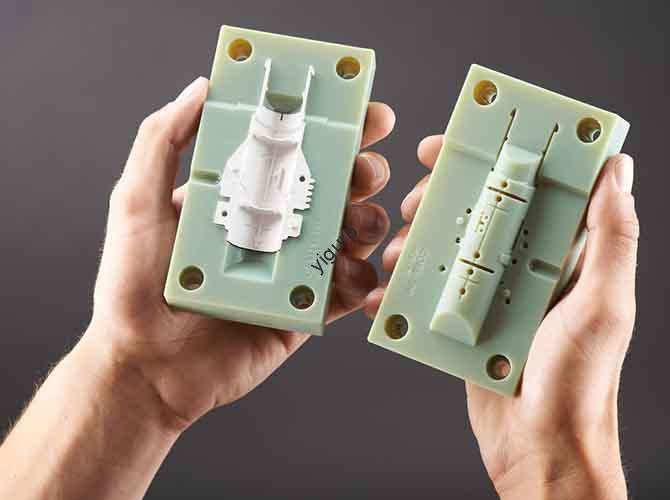Nel mondo manifatturiero frenetico di oggi, how can businesses cut production time, ridurre i costi, and still meet high customization demands? La risposta sta dentro 3D printing fixtures—specialized tools made via 3D printing to support, Presa, and position workpieces during industrial processes. Unlike traditional fixtures, these tools combine precision, flessibilità, ed efficienza, making them indispensable in key sectors like aerospace and medical manufacturing. Below is a comprehensive guide to understanding, designing, and leveraging 3D printing fixtures.
1. What Are 3D Printing Fixtures, and Why Do You Need Them?
Al loro centro, 3D printing fixtures are custom-manufactured tools created using 3D printing technology for specific industrial operations (PER ESEMPIO., Sintering, assemblaggio, or inspection). They solve three critical pain points of traditional fixtures:
| Pain Point of Traditional Fixtures | Solution from 3D Printing Fixtures |
| Lunghi cicli di produzione (4–8 settimane) | Shortened lead time (3–7 giorni) |
| High cost for small-batch orders | 30–50% lower manufacturing costs |
| Rigid design (hard to modify) | Fully customizable for unique workpieces |
Per esempio, a medical device manufacturer once struggled to produce small-batch fixtures for orthopedic implant sintering. Passando alla stampa 3D, they reduced fixture production time from 6 settimane a 5 days and cut costs by 40%—all while ensuring the fixtures matched the implants’ exact shapes.
2. Flusso di lavoro passo-passo: From Design to Deployment
Creating effective 3D printing fixtures segue un percorso lineare, four-stage process. Each step is critical to ensuring the final fixture meets performance and precision requirements.
Palcoscenico 1: Design personalizzato & Ottimizzazione
- Needs Analysis: Primo, define the fixture’s purpose (PER ESEMPIO., high-temperature sintering or delicate electronic assembly) and the workpiece’s specs (misurare, materiale, peso).
- Modellazione CAD: Use software like SolidWorks or AutoCAD to build a 3D model tailored to the workpiece. Ad esempio, a fixture for a titanium aerospace part would include grooves to match the part’s curved surface.
- Ottimizzazione del modello: Adjust the design to fit 3D printing constraints—add fillets to reduce stress, optimize wall thickness (usually 2–5mm for durability), and avoid overhangs that require extra support.
Palcoscenico 2: Selezione del materiale (The Make-or-Break Choice)
Choosing the right material ensures the fixture performs in its intended environment. Key factors include thermal stability, resistenza all'usura, and compatibility with the workpiece.
| Tipo di materiale | Proprietà chiave | Applicazioni ideali |
| Ceramica | Resistenza ad alta temperatura (fino a 1.600 ° C.), bassa espansione termica | Powder metallurgy sintering |
| Metallo (PER ESEMPIO., alluminio, acciaio inossidabile) | Alta resistenza, resistenza all'usura | Aerospace part assembly, heavy-load holding |
| Graphite | Eccellente conduttività termica, inerzia chimica | High-precision electronic component processing |
Per la punta: Always match the fixture’s thermal expansion coefficient to the workpiece. Per esempio, if the workpiece is made of stainless steel (coefficiente di espansione termica: 17.3 × 10⁻⁶/° C.), choose a stainless steel fixture to avoid warping during heating.
Palcoscenico 3: 3D Printing Execution
- Preparazione di stampa: Import the optimized CAD model into slicing software (PER ESEMPIO., Cura). Imposta parametri:
- Altezza strato: 0.1–0,2 mm (per alta precisione)
- Riempire la densità: 50–80% (balances weight and strength)
- Printing speed: 30–60 mm/s (avoids layer separation)
- Stampa: Start the 3D printer (FDM for plastics, SLS for metals). The printer builds the fixture layer by layer—no molds or tooling needed.
Palcoscenico 4: Post-elaborazione & Controllo di qualità
| Fare un passo | Scopo | Come farlo |
| Rimuovere le strutture di supporto | Eliminate extra material used during printing | Use pliers for FDM parts; sandblasting for SLS parts |
| Trattamento superficiale | Improve smoothness and durability | Sand with 200–400 grit sandpaper; polish with a buffer for metal parts |
| Ispezione di qualità | Ensure compliance with design specs | Use a caliper to check dimensions; Usa una macchina di misurazione delle coordinate (CMM) per parti ad alta precisione |
3. Applicazioni chiave: Where 3D Printing Fixtures Shine
3D printing fixtures are not one-size-fits-all—they excel in sectors where customization and performance are non-negotiable. Here are four major use cases:
- Aerospaziale: Hold lightweight, parti complesse (PER ESEMPIO., lame di turbina) during drilling. Fixtures are made of aluminum for strength and low weight.
- Medico: Support custom orthopedic implants (PER ESEMPIO., Sostituzioni dell'anca) during sintering. Ceramic fixtures withstand high temperatures without contaminating the implant.
- Elettronica: Position tiny circuit boards during soldering. Plastic fixtures (PER ESEMPIO., Pla) are non-conductive and protect sensitive components.
- Powder Metallurgy: Shape metal powders into finished parts. Graphite fixtures ensure even heat distribution during sintering.
4. Yigu Technology’s Perspective on 3D Printing Fixtures
Alla tecnologia Yigu, Abbiamo visto in prima persona come 3D printing fixtures transform manufacturing. Many clients initially hesitate to switch from traditional fixtures, worried about cost or performance—but after testing, they’re amazed by the 30–50% cost reduction and 70% faster lead times. Ti consigliamo di iniziare in piccolo: use 3D printing for low-volume, high-customization fixtures (PER ESEMPIO., prototipi di dispositivi medici) before scaling up. Our team also helps optimize designs and select materials, ensuring fixtures meet even the strictest industry standards (PER ESEMPIO., aerospace AS9100).
Domande frequenti: Your Top 3D Printing Fixture Questions Answered
Q1: Can 3D printing fixtures replace all traditional fixtures?
No—for high-volume production (10,000+ unità), traditional fixtures (PER ESEMPIO., CNC-machined metal) può essere ancora più economico. Ma per piccoli lotti, prototipi, or custom parts, 3D printing fixtures are far more cost-effective.
Q2: How long does a 3D printing fixture last?
It depends on the material and usage. Metal fixtures can last 2–5 years (per uso regolare), while ceramic fixtures last 3–7 years in high-temperature environments. Plastic fixtures (PER ESEMPIO., Pla) are best for short-term projects (6–12 mesi).
Q3: Do I need special software to design 3D printing fixtures?
Basic CAD software (PER ESEMPIO., Fusione 360) works for simple fixtures. Per design complessi (PER ESEMPIO., parti aerospaziali), use specialized software like ANSYS to simulate stress and thermal performance before printing.
